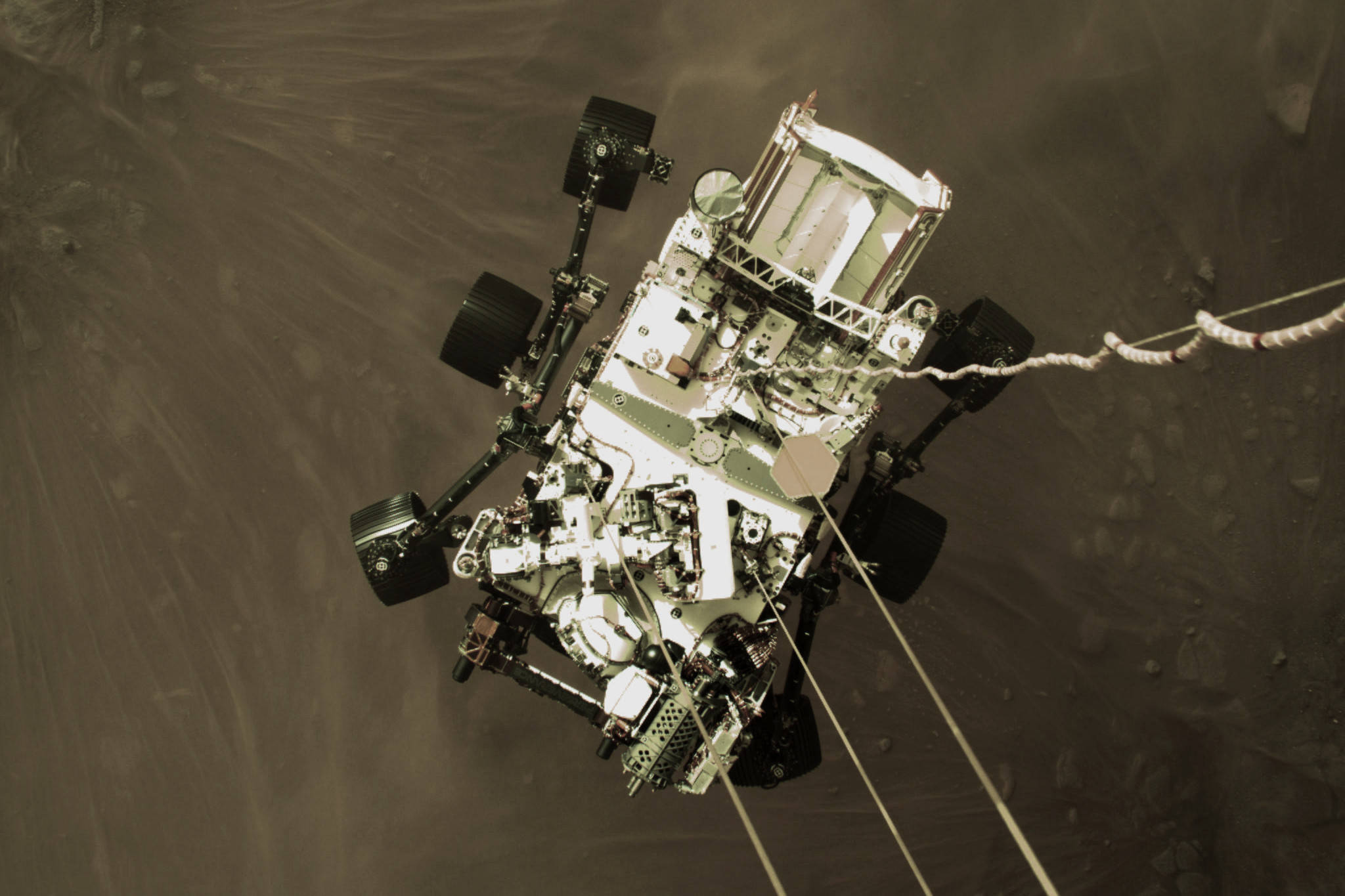Years of work by the Jet Propulsion Laboratory’s engineers and scientists culminated in a moment celebrated across the world when the Perseverance Rover landed on Mars on Feb. 18, 2021.
Now that the rover is in its new workplace in the Jezero Crater, north of the equator of Mars, it’ll get out of travel mode and into work mode, said Bekah Siegfriedt, a mission operations system engineer at JPL, a part of NASA.
“We’re gonna start getting data down from the rover in an hour and a half. We’ve been getting a ton of video and images from the landing. Because we’ve recorded video and even sound those are bigger files they take a while to come down,” said Siegfriedt in a phone interview as she came on-shift Wednesday. “Over the next month or so, maybe a little longer, we start doing our first-time activities. This is the first time we drive, the first time we use the arm.”
Perseverance and its accompanying helicopter Ingenuity are part of the Mars 2020 mission, which launched from Cape Canaveral on July 30, 2020, according to NASA’s Perseverance facts. The mission is going smoothly, Siegfriedt, with the rover having spent six sols on-planet so far. A sol is one rotation, or day-night cycle, of Mars on its axis and it’s about 24 hours and 40 minutes.
Mars 2020 was designed from the outset to look for habitability, look for signs of microbial life and test oxygen production in the Martian atmosphere, according to the mission page.
A new breed of explorer
“Every time we build a new rover and we land it, we’re building off the past and improving it,” Siegfriedt said. “With this one, we’ve learned so much from our past missions that the first few sols have gone really smoothly. I’ve been pleasantly surprised and delighted by how well it’s going.”
Perseverance is an incremental improvement on its forebears, Siegfriedt said.
“We just built on what we’ve done with Curiosity,” Siegfriedt said. “Curiosity was a very different rover than Spirit and Opportunity.”
Perseverance will be the second of JPL’s rovers to be powered by a radioisotope thermoelectric generator, Siegfriedt said. An RTG uses the heat released by radioactive materials as a stable, long-lasting power source. It is not the same as a nuclear reactor.
“It’s a lot more reliable. We don’t have to worry about dust accumulating on the solar panels, which ultimately killed both rovers (Spirit and Curiosity),” Siegfriedt said. “There’s a bet going around with how long the RTG is going to last for Perseverance. It also depends on the condition of the batteries. The RTG is constantly putting out energy, but the batteries power the rover. If you think about your cell phone, you get a new phone every couple years because of your batteries.”
Perseverance also brought a friend — a first-of-its-kind rotorcraft named Ingenuity — that will increase the rover’s effectiveness exponentially. Ingenuity will allow operators to explore the area around Perseverance, allowing them to pick the safest and most efficient path without tedious exploration by the rover itself.
“It has to fly in an atmosphere that’s 1% of earth’s atmosphere,” Siegfriedt said.”The blades are huge compared to the package of the helicopter itself.”
Strange past, bright future
The Mars 2020 mission was announced in 2012, with instrument selection occurring in 2014, according to the mission’s website.
Scheduled for a July 2020 launch, Perseverance’s launch window occurred squarely in the middle of the breaking wave of the coronavirus pandemic. Siegfriedt also had a child during the pandemic, no small event.
“This year has been so hard on our team. We had to figure out to finish getting the rover ready for launch, launch, do its cruise operations, and land it, during a pandemic,” Siegfriedt said. “If (the coronavirus) had hit the year before, I don’t know what would have happened.”
While the rover itself was physically assembled in the clean rooms of JPL’s Pasadena facility, outside of Los Angeles, the rover still needed to have its software fine-tuned, Siegfriedt said.
“Somehow we have been able to manage to do that from our homes,” Siegfriedt said. “But the project has been so good about working with us.”
JPL mandate is to get at least three Earth years or 1.5 Mars year of operation out of the rover, Siegfriedt said, but hopes that they can get many more.
“We build everything with a ton of margin. We hope Perseverance can last longer and do more science,” Siegfriedt said. “The RTG should last us 50 years or so. The batteries are the million-dollar question.”
The rover’s mission includes a directive to collect and cache mineral samples for retrieval by a future flight, Siegfriedt said.
And what did Siegfriedt think was the coolest part of the new rover?
“I think the microphone. Every rover we’ve sent has developed a new human sense. This rover is the first one where we’ve given it ears. We’ve already got data back where we can hear the sounds of Mars, the wind. It actually provides more data than we thought,” Siegfriedt said. “This is the first time we’ve been able to hear the sounds of Mars. Giving the rover a sense of hearing is awesome and I think it’s awesome that people who are visually impaired can be a part of our mission.”

